1.
Introduction
Path algebras are very important in representation theory and related mathematical fields, it is interesting to study their counterparts in higher representation theory [21,20]. The n-slice algebra is introduced and studied in [15] as the quadratic dual of an n-properly-graded algebra whose trivial extension is an n-translation algebra (see Section 2 for the details). The n-slice algebra was called dual τ-slice algebra in [14,17], for studying algebras related to the higher representation theory introduced and studied by Iyama and his coauthors [21,22,20]. The n-slice algebras bear some interesting features of path algebras in higher dimensional representation theory setting: the τn-closures, higher dimensional counterparts of preprojective and preinjective components, are truncations of Z|n−1Q, a higher version of ZQ [15], and the n-APR tilts and colts can be realized by τ-mutations in Z|n−1Q⊥,op [17], which is obtained by removing a source (resp. sink) and adding a corresponding sink (resp. source).
It is well known that the path algebras of acyclic quivers are classified as finite, tame and wild representation types according to their quivers. This classification has a great influence in representation theory. When Iyama and his coauthors study n-hereditary algebras, they define and study n-representation-finite and n-representation-infinite algebras, they also define and study n-representation-tame algebras inside n-representation-infinite algebras [22,23,20]. Recently, Lee, Li, Mills, Schiffler and Seceleanu give a new characterization of such classification for acyclic quivers in terms of their frieze varieties [24]. The classification of path algebras can also be read out from their preprojective algebras, that is, a path algebra is of finite representation type if and only if its preprojective algebra is finite dimensional, is of tame representation type if and only if its preprojective algebra is of finite Gelfand-Kirilov dimension, and is of wild representation type if and only if its preprojective algebra is of infinite Gelfand-Kirilov dimension [9].
Regarding n-slice algebra as a higher version of path algebra, in this paper, we generalize the classification of path algebras via (n+1)-preprojective algebras and related n-translation algebras. By using the results in [18], we get that for an n-slice algebra, its (n+1)-preprojective algebra is either of finite dimension, of finite Gelfand-Kirilov dimension or of infinite Gelfand-Kirilov dimension. The trivial extension of the quadratic dual of an n-slice algebra is a stable n-translation algebra, so it is either weakly periodic, of finite complexity and of infinite complexity, accordingly. In this way we classify the n-slice algebras as finite type, tame type or wild type according to their (n+1)-preprojective algebras or according to the trivial extensions of their quadratic duals.
McKay quiver for a finite subgroup of a general linear group is introduced in [27], which connects representation theory, singularity theory and many other mathematical fields. McKay quiver is also very interesting in studying higher representation theory of algebras [20,15]. Over the algebraically closed field of characteristic zero, the preprojective algebras of path algebras of tame type are Morita equivalent to the skew group algebras of finite subgroups of SL(2,C) over the polynomial algebra of two variables [29,8]. Inspired by this results, it is observed in [16] that the skew group algebras of a finite subgroup G of GL(n+1,C) over the exterior algebra of an (n+1)-dimensional vector space, and over polynomial algebra of n variables, have the McKay quiver of G as their Gabriel quivers. The former of these algebras is an n-translation algebra and the later is a Noetherian Artin-Schelter regular algebra of Gelfand-Kirilov dimension n+1. In this paper, we show that by constructing universal cover, taking τ-slices, and then taking quadratic duals, we obtain tame n-slice algebras associate to the McKay quiver of a finite subgroup of GL(n+1,C). In this process, we get three pairs of quadratic dual algebras related to a McKay quiver. We present some interesting equivalences of triangulate categories related to these algebras, among them we get a version of Beilinson correspondence and a version of Bernstein-Gelfand-Gelfand correspondences related to McKay quivers.
We also describe the quivers and relations for the tame 2-slice algebras related to McKay quivers. We characterized the relations for 2-slice algebras associated to the McKay quivers of finite Abelian subgroup of SL(3,C) and of finite subgroup of SL(3,C) obtained by embedding SL(2,C) into SL(3,C). The relations of the 2-translation algebras and AS-regular algebras related to the McKay quivers are described first, and the quivers and relations for the associated 2-slice algebras follow immediately.
The paper is organized as follows. In Section 2, concepts and results needed in this paper are recalled. We recall the constructions of the n-translation quivers related to an n-properly-graded quiver, and the algebras related to an n-slice algebra. We also recalled notions and results in [18] needed in Section 3. In Section 3, we discuss the classification of n-slice algebras via the stable n-translation algebras and the (n+1)-preprojective algebras related to them. In Section 4, we discuss the McKay quivers of some finite subgroups of SL(n+1,C). We also discuss the tame n-slice algebras associated to the McKay quivers of the finite subgroups in SL(n+1,C) and present the equivalences of the related triangulate categories. In the last section, we describe the relations for the stable 2-translation algebra, the AS-regular algebras and 2-slice algebras related to the McKay quivers of finite Abelian subgroups of SL(3,C) and finite subgroups of SL(3,C) obtained by embedding SL(2,C) into SL(3,C).
2.
Preliminary
In this paper, we assume that k is a field, and Λ=Λ0+Λ1+⋯ is a graded algebra over k with Λ0 a direct sum of copies of k such that Λ is generated by Λ0 and Λ1. Such algebra is determined by a bound quiver Q=(Q0,Q1,ρ) [13].
Recall that a bound quiver Q=(Q0,Q1,ρ) is a quiver with Q0 the set of vertices, Q1 the set of arrows and ρ a set of relations. The arrow set Q1 is usually defined with two maps s,t from Q1 to Q0 to assign an arrow α its starting vertex s(α) and its ending vertex t(α). Write Qt for the set of paths of length t in the quiver Q, and write kQt for space spanned by Qt. Let kQ=⨁t≥0kQt be the path algebra of the quiver Q over k. We also write s(p) for the starting vertex of a path p and t(p) for the terminating vertex of p. Write s(x)=i if x is a linear combination of paths starting at vertex i, and write t(x)=j if x is a linear combination of paths ending at vertex j. The relation set ρ is a set of linear combinations of paths of length ≥2. We may assume that the paths appearing in each of the element in ρ have the same length, since we deal with graded algebra. Through this paper, we assume that the relations are normalized such that each element in ρ is a linear combination of paths of the same length starting at the same vertex and ending at the same vertex. Conventionally, modules are assumed to be finitely generated left module in this paper.
Let Λ0=⨁i∈Q0ki, with ki≃k as algebras, and let ei be the image of the identity in the ith copy of k under the canonical embedding. Then {ei|i∈Q0} is a complete set of orthogonal primitive idempotents in Λ0 and Λ1=⨁i,j∈Q0ejΛ1ei as Λ0-bimodules. Fix a basis Qij1 of ejΛ1ei for any pair i,j∈Q0, take the elements of Qij1 as arrows from i to j, and let Q1=∪(i,j)∈Q0×Q0Qij1. Thus Λ≃kQ/(ρ) as algebras for some relation set ρ, and Λt≃kQt/((ρ)∩kQt) as Λ0-bimodules. A path whose image is nonzero in Λ is called a bound path.
A bound quiver Q=(Q0,Q1,ρ) is called quadratic if ρ is a set of linear combination of paths of length 2. In this case, Λ=kQ/(ρ) is called an quadratic algebra. Regard the idempotents ei as the linear functions on ⨁i∈Q0kei such that ei(ej)=δi,j, and for i,j∈Q0, arrows from i to j are also regarded as the linear functions on ejkQ1ei such that for any arrows α,β, we have α(β)=δα,β. By defining α1⋯αr(β1,⋯,βr)=α1(β1)⋯αr(βr), ejkQrei is identified with its dual space for each r and each pair i,j of vertices, and the set of paths of length r is regarded as the dual basis to itself in ejkQrei. Take a spanning set ρ⊥i,j of orthogonal subspace of the set ejkρei in the space ejkQ2ei for each pair i,j∈Q0, and set
The quadratic dual quiver of Q is defined as the bound quiver Q⊥=(Q0,Q1,ρ⊥), and the quadratic dual algebra of Λ is the algebra Λ!,op≃kQ/(ρ⊥) defined by the bound quiver Q⊥ (see [14]).
2.1. n-properly-graded quiver and related n-translation quivers
To define and study n-slice and n-slice algebra, we need n-properly-graded quiver and related quivers.
Recall that a bound quiver Q=(Q0,Q1,ρ) is called n-properly-graded if all the maximal bound paths have the same length n. The graded algebra Λ=kQ/(ρ) defined by an n-properly-graded quiver is called an n-properly-graded algebra.
Let Q be an n-properly-graded quiver with n-properly-graded algebra Λ, let M=MQ be a maximal linearly independent set of maximal bound paths in Q. Define the returning arrow quiver ˜Q=(˜Q0,˜Q1) with vertex set ˜Q0=Q0, arrow set ˜Q1=Q1∪Q1,M, with Q1,M={βp:t(p)→s(p)|p∈M}. By proposition 3.1 of [14], ˜Q is the quiver of the trivial extension ΔΛ of Λ. So there is a relation set ˜ρ, such that ΔΛ≃k˜Q/(˜ρ). We use the same notation ˜Q for the bound quiver ˜Q=(˜Q0,˜Q1,˜ρ). By Lemma 3.2 of [14], the relation set ˜ρ can be chosen as a union ρ∪ρM∪ρ0 of three sets, the relation set ρ of Q, the set ρM of all paths formed by two returning arrows from Q1,M, and a set ρ0 of linear combinations of paths containing exactly one returning arrow.
The n-translation quiver and n-translation algebra are introduced to study higher representation theory related to graded self-injective algebras in [13]. The bound quivers of a graded self-injective algebras are exactly the stable n-translation quivers, with the Nakayama permutation τ as its n-translation [13] (called stable bound quiver of Loewy length n+2 in [12]). Since ΔΛ is a graded symmetric algebra, the returning arrow quiver ˜Q is a stable n-translation quiver with trivial n-translation.
With an n-properly-graded quiver Q, we can also define an acyclic stable n-translation quiver Z|n−1Q, via its returning arrow quiver ˜Q, as the bound quiver with vertex set
and arrow set
with
and
The relation set of Z|n−1Q is defined as ρZ|n−1Q=Zρ∪ZρM∪Zρ0, where
and
when the returning arrow quiver ˜Q is quadratic. The quiver Z|n−1Q is a locally finite infinite quiver if Q is locally finite. It is a quiver with infinite copies of Q with successive two neighbours connected by the returning arrows. With the n-translation τ defined by sending each vertex (i,t) to (i,t−1), Z|n−1Q is a stable n-translation quiver.
Recall a complete τ-slice in an acyclic stable n-translation quiver is a convex full bound sub-quiver which intersect each τ-orbit exactly once. It is obvious that each copy of Q in Z|n−1Q is a complete τ-slice.
Given a finite stable n-translation quiver ˜Q, we can construct another infinite acyclic stable n-translation quiver Z⋄˜Q=(Z⋄˜Q0,Z⋄˜Q1,ρZ⋄˜Q) as follows (denoted by ¯Q and called separated directed quiver in [12]) with the vertex set
and the arrow set
If p=αs⋯α1 is a path in ˜Q, define p[m]=(αs,m+s−1)⋯(α1,m), and for an element z=∑tatpt with each pt a path in ˜Q, at∈k, define z[m]=∑tatpt[m] for each m∈Z. Define relations
here ζ[m]=∑tatpt[m] for each ζ=∑tatpt∈ρ. Z⋄˜Q is a locally finite bound quiver if Q is so.
A connected quiver Q is called nicely-graded if there is a map d from Q0 to Z such that d(j)=d(i)+1 for any arrow α:i→j.
Clearly, a nicely graded quiver is acyclic.
Proposition 2.1. 1. Let d be the greatest common divisor of the length of cycles in ˜Q, then Z⋄˜Q has d connected components.
2. All the connected components of Z⋄˜Q are isomorphic.
3. Each connected component of Z⋄˜Q is nicely graded quiver.
Proof. The first and the second assertions follow from Proposition 4.3 and Proposition 4.5 of [12], respectively. The last follows from the definition of Z⋄˜Q.
An n-properly-graded quiver is called n-nicely-graded quiver if it is nicely-graded.
Proposition 2.2. Assume that Q is an n-nicely-graded quiver. Let ˜Q be the returning arrow quiver of Q. Then Z|n−1Q is isomorphic to a connected component of Z⋄˜Q, hence is also nicely graded.
Proof. Let d:Q0→Z be the function such that d(j)=d(i)+1 for an arrow α:i→j in Q. Fix an vertex i0∈Q0, define ϕ:Z|n−1Q0→Z⋄˜Q by
It is easy to see that ϕ is an isomorphism from Z|n−1Q to the connected component of Z⋄˜Q containing the vertex (i0,0).
By definition, an n-translation quiver is an (n+1)-properly graded quiver. The bound quiver Z|n−1Q is an (n+1)-nicely graded quiver and the n-translation sends the ending vertex of a maximal bound path of length n+1 to its starting vertex. So by the definition of complete τ-slice, we immediately have the following.
Proposition 2.3. If ˜Q is a stable n-translation quiver. Then any complete τ-slice in Z⋄˜Q is an n-nicely-graded quiver.
Let m≤l be two integers, write Z⋄Q[m,l] for the full subquiver of Z⋄˜Q with vertex set
Z⋄Q[m,l] is a convex subquiver of Z⋄˜Q, so it is regarded as a bounded subquiver by taking
By Proposition 6.2 of [12], we get the following for any m.
Proposition 2.4. Z⋄Q[m,m+n] is a complete τ-slice of Z⋄˜Q.
The complete τ-slice Z⋄Q[0,n] is called an initial τ-slice in [12]. If the quiver Q is nicely graded, by Lemma 6.5 of [12], we can recover our quiver Q by using τ-mutations on a connected component of Z⋄Q[m,m+n].
Starting with an acyclic n-properly-graded quiver Q, we construct its returning arrow quiver ˜Q, which is a stable n-translation quiver. With ˜Q, we construct a universal cover Z|n−1Q, which is an acyclic stable n-translation quiver, or construct a universal cover Z⋄˜Q, which is a nicely-graded stable n-translation quiver. We can recover Q as a complete τ-slice of Z|n−1Q, and when Q is a nicely-graded, we can recover it as a connected component of complete a τ-slice of Z⋄˜Q.
We have the following picture to illustrate the relationship among these quivers.
2.2. n-slice algebras and related algebras
The quadratic dual quiver Q⊥=(Q0,Q1,ρ⊥) of an acyclic quadratic n-properly-graded quiver Q is called an n-slice.
Recall that a graded algebra ˜Λ=∑t≥0˜Λt is called a (p,q)-Koszul algebra if ˜Λt=0 for t>p and ˜Λ0 has a graded projective resolution
such that Pt is generated by its degree t part for t≤q and kerfq is concentrated in degree q+p [6,13]. A graded algebra defined by an n-translation quiver ˜Q is called an n-translation algebra, if there is a q≥2 or q=∞ such that ˜Λ is an (n+1,q)-Koszul algebra [13]. A stable n-translation algebra ˜Λ is a (n+1,q)-Koszul self-injective algebra for some q≥2 or q=∞, and we call q the Coxeter index of ˜Λ.
Let Λ be the n-properly-graded algebra defined by Q, if the trivial extension ΔΛ is a stable n-translation algebra, the algebra Γ=kQ/(ρ⊥) defined by the n-slice Q⊥ is called an n-slice algebra.
The following Proposition justifies the name n-slice.
Proposition 2.5. Let Γ be an acyclic n-slice algebra with bound quiver Q⊥, then Q is a complete τ-slice of the n-translation quiver Z|n−1Q and Λ=Γ!,op is a τ-slice algebra.
Starting with a quadratic acyclic n-properly-graded quiver Q, let Λ be the n-properly-graded algebra defined by Q and let Γ be the algebra defined by the n-slice Q⊥. If ˜Q is a quadratic quiver, write ˜Q⊥ for its quadratic dual quiver. In this case, Z|n−1Q and Z⋄Q are also quadratic quivers, write Z|n−1Q⊥ and Z⋄Q⊥ for their quadratic dual quivers, respectively.
With the quivers related to Q defined above and their quadratic duals, we have interesting algebras. We associate the trivial extension ˜Λ=ΔΛ of Λ to the returning arrow quiver ˜Q. If Γ is an n-slice algebra, we associate the (n+1)-preprojective algebra ˜Γ=Π(Γ) of Γ to a twist ˜Q⊥,ν of its quadratic dual, by Corollary 5.4 of [14].
We also associate algebras to the bound quivers Z|n−1Q and Z⋄˜Q by constructing smash products over ˜Λ. Note that ˜Λ is generated by the returning arrows over Λ. Taking Λ as degree zero component and taking the returning arrows as degree 1 generators, we get a Z-grading on ˜Λ induced by the n-translation. Construct the smash product ˜Λ#kZ∗ of ˜Λ with respect to this grading. It is shown in Section 5 of [13] that Z|n−1Q is the bound quiver of ˜Λ#kZ∗.
Taking the usual path grading on ˜Λ, that is, taking Λ0 as the degree 0 component and taking the arrows in ˜Q as degree 1 generators, we get a Z-grading on ˜Λ induced by the lengths of the paths of k˜Q. Construct the smash product of ˜Λ#′kZ∗ with respect to this grading. By Theorem 5.12 of [12], Z⋄˜Q is the bound quiver of ˜Λ#′kZ∗.
So we can get criteria for Γ to be n-slice algebra using ˜Λ#kZ∗ and ˜Λ#′kZ∗. Note that ˜Q is always an n-translation quiver, so ˜Λ is n-translation algebra if and only if there is a q≥2 or q=∞, such that ˜Λ is (n+1,q)-Koszul. By Propositions 2.2 and 2.6 of [13], ˜Λ is (n+1,q)-Koszul if and only if ˜Λ!,op is (q,n+1)-Koszul. We also get the following criterion for Γ to be an n-slice algebra.
Proposition 2.6. Let Γ be the algebra defined by an n-slice Q⊥. Then Γ is an n-slice algebra if and only if there is a q≥2 or q=∞, such that the (n+1)-preprojective algebra Π(Γ) is (q,n+1)-Koszul.
Write Z|n−1Q⊥ and Z⋄˜Q⊥ for the quadratic duals of Z|n−1Q and Z⋄˜Q, respectively. Write ˆΛ for the algebra defined by Z|n−1Q or Z⋄˜Q, and write ˆΓ for the algebra defined by Z|n−1Q⊥ or Z⋄˜Q⊥. We have the following picture depicting the relationship of these algebras:
The left triangle is induced by the picture (4) depicting quivers. The left vertically up arrow indicate taking a τ-slice algebra when ˆΛ=˜Λ#kZ∗, and indicate taking a direct summand of τ-slice algebra when ˆΛ=˜Λ#′kZ∗.
2.3. Loewy matrix and Koszul cone of stable n-translation algebra
Now we assume that ˜Λ=∑n+1t=0˜Λt is a stable n-translation algebra, that is, it is an (n+1,q)-Koszul self-injective algebra, with finite bound quiver ˜Q. Let ˜Q0={1,2,…,m}. Then ˜Λ is unital with 1=e1+⋯+em. We need some results in [18] concerning the complexities of ˜Λ and the Gelfand-Kirilov of its quadratic dual ˜Λ!,op.
For 0≤t≤n+1, define
Let E be the m×m identity matrix, then A0(˜Λ)=E.
The Loewy matrix L(˜Λ) for ˜Λ is defined in [18] as a matrix
with size (n+1)m×(n+1)m.
Let M=Mh+⋯+Mh+n be a graded ˜Λ-module of Loewy length ≤n+1 generated in degree h. The level dimensional vector l.dimM is defined as
where dimMt is the dimensional vector of Mt as a ˜Λ0-module. Recall the syzygy ΩM of M is the kernel of the projective cover P(M)→M. Thus ΩM=0 if M is projective, and there is an exact sequence 0→ΩM→P(M)→M→0 if M is not projective. Write Ωt+1M=Ω(ΩtM).
Assume that ˜Λ is graded self-injective, if a finitely generated graded ˜Λ-module M without projective summands has a minimal projective resolution
such that Pt is generated in degree h+t for t≤s, then the level dimensional vector for ΩsM is defined and we have
by Proposition 1.1 of [18].
Write 0 for the zero vector or zero matrix. We call a matrix (vector) nonnegative if all the entries are ≥0, positive if it is nonnegative and at least one entry is >0. We call a matrix (vector) negative if its opposite is positive. For two vectors (matrices) v and v′, write v≤v′ if v′−v is nonnegative and write v<v′ if v′−v is positive. Write
The following Proposition follows from (9) and the definition of the (p,q)-Koszul algebra.
Proposition 2.7. Assume that ˜Λ is a stable n-translation algebra with Coxeter index q. Then q is finite if and only if Lq+1(˜Λ)V0 is negative.
Now assume that q=∞, then ˜Λ is a Koszul self-injective algebra of Loewy length n+2. Write K for the real cone spanned by the level dimensional vectors of finitely generated Koszul ˜Λ-modules, called Koszul cone in [18], and K is contained in the positive cone in the real space R(n+1)m. Let ϱ=ϱL(˜Λ) be the spectral radius of L(˜Λ), that is, the maximal norm of its (complex) eigenvalues, which is called the size of the biggest Jordan block of the eigenvalue λi the algebraic degree of λi.
We can restate the Theorems 2.4 and 2.5 of [18] as follows.
Proposition 2.8. K is a solid cone invariant under the linear transformation defined by L(˜Λ).
Then by Theorem 3.1 of [30], ϱ is an eigenvalue of L(˜Λ) with maximal algebraic degree among the eigenvalues with norm ϱ. By Theorem 2.7 of [18], we have ϱ≥1.
The following is part (a) of Proposition 2.9 of [18].
Proposition 2.9. Let ˜Λ be a Koszul stable n-translation algebra. Let ϱ be the spectral radius of the Loewy matrix L(˜Λ) with algebraic degree d. Then for any vector v∈K, there exists an integer 1≤d′≤d, such that L(v,d′)={Lr(˜Λ)vrd′−1ϱr|r∈N} is a compact set in K and there exists a sequence r1<r2<⋯ of integers and a vector v0 with nonnegative entries such that limj→∞Lrj(˜Λ)vrd′−1jϱrj=v0.
Let M be a ˜Λ-module. Recall that the complexity c˜Λ(M) of M is defined as the least non-negative number d such that there exists λ>0 with dimkΩ(t)M≤λ⋅td−1 for almost all t, or infinite if no such t exist. The complexity c(˜Λ) of an algebra ˜Λ is defined as the supremum of the complexities of finitely generated ˜Λ-modules.
By applying Proposition 2.9, the following is proved as Theorem 2.10 in [18].
Proposition 2.10. If ϱ>1, then c˜Λ(M)=∞ for any non-projective Koszul ˜Λ-module M.
Recall that for a graded algebra Γ=Γ0+Γ1+⋯ generated by Γ0 and Γ1, the Gelfand-Kirilov dimension GKdimΓ is defined as
By using Koszul duality, the Gelfand-Kirilov dimension of the quadratic dual ˜Γ=˜Λ!,op is also discussed in [18].
The following is Theorem 3.2 in [18]. Let ˜Λ be a Koszul stable n-translation algebra, and write ˜Γ=˜Λ!,op.
Theorem 2.11. If ϱ=1 and d is the algebraic degree of the spectral radius, then GKdim˜Γ=d.
If ϱ>1, then GKdim˜Γ=∞.
The following is Theorem 3.1 in [18].
Theorem 2.12. If ˜Γ is Noetherian, then ϱ=1.
3.
Classification of n-slice algebras
By picture (6), we see an n-slice algebra Γ is related to a stable n-translation algebra ˜Λ=(Π(Γ))!,op.
To classify the n-slice algebras, we first discuss a classification of the stable n-translation algebras, by expanding the theory developed in [18]. Let L(˜Λ) be the Loewy matrix of ˜Λ, and ϱ be the spectral radius of L(˜Λ).
We call an algebra ˜Λ weakly periodic if there is an integer l such that Ωl˜Λ0≃˜Λ0 as ˜Λ-module. We remark that in the literature, an algebra ˜Λ is called periodic algebra if there is an integer l such that Ωl˜Λe˜Λ≃˜Λ as ˜Λe-module for the envelop algebra ˜Λe=˜Λop⊗˜Λ.
Lemma 3.1. A stable n-translation algebra ˜Λ is weakly periodic if and only if its Coxeter index q is finite.
Proof. For stable n-translation algebra ˜Λ with finite q, the (q+1)th syzygy Ωq+1˜Λ0ei of a simple ˜Λ-module ˜Λ0ei is a module concentrated in degree n+1+q, by the definition. So Ωq+1˜Λ0ei is semi-simple. Since ˜Λ is self-injective, the syzygies of an indecomposable module are all indecomposable. Thus Ωq+1˜Λ0ei is simple, and action of Ωq+1 permutes the simples. This implies that there is a l>0 such that Ωl(q+1) acts trivially on the simples and ˜Λ is weakly periodic.
Now assume that ˜Λ is weakly periodic with minimal period q′+1, then by the definition Ωq′+1˜Λ0≃˜Λ0 with finite q′. So it is semi-simple and hence concentrated in degree n+1+q′, since all the projective modules have the Loewy length n+1. Since ˜Λ is (n+1,q)-Koszul, so q′≥2 and we see in the projective resolution (5) of ˜Λ0, Pt is generated in degree t for t≤q′ and kerfq=Ωq′+1˜Λ0 is concentrated in degree n+1+q′. So q=q′ is finite.
Clearly, being weakly periodic is a special case of complexity 1.
We have the following characterization of the periodicity and of the complexities for stable n-translation algebras using Loewy matrices.
Theorem 3.2. Let ˜Λ be a stable n-translation algebra with Coxeter index q and Loewy matrix L(˜Λ). Then
1. The algebra ˜Λ is weakly periodic if and only if there is an positive integer h, such that Lh(˜Λ)V0 is negative;
2. The algebra ˜Λ is of finite complexity if and only if q is infinite and the spectral radius of L(˜Λ) is 1;
3. The algebra ˜Λ is of infinite complexity if and only if q is infinite and the spectral radius of L(˜Λ) is larger than 1.
Proof. Assume that ˜Λ is (n+1,q)-Koszul algebra. By Lemma 3.1, ˜Λ is weakly periodic if and only if q is finite. By Proposition 2.7, q is finite if and only if Lh(˜Λ)v0 is negative for h=q+1. This proves the first assertion.
Now assume that q is infinite, then ˜Λ is Koszul. By proposition 2.8, K is a solid cone invariant under the action of Loewy matrix L(˜Λ). By Theorem 3.1 of [30], the spectral radius ϱ is an eigenvalue of L(˜Λ) with maximal algebraic degree among the eigenvalues with norm ϱ. Note that the constant term of the characteristic polynomial of L(˜Λ) is 1 (see also Theorem 2.7 of [18]). So ϱ≥1.
If ϱ>1, by Proposition 2.10, ˜Λ is of infinite complexity.
Now assume that ϱ=1, then by Proposition 2.9, there exists an integer 1≤d′≤d, such that {Lr(˜Λ)l.dimMrd′−1|r∈N} is bounded set for any finitely generated Koszul ˜Λ-module M. So l.dimΩrM=Lr(˜Λ)l.dimM≤rd−1v for some positive vector v. This implies that for sufficient large r, dimkΩrM≤λrd−1 for some positive λ. So the complexity of M is ≤d. This proves that ˜Λ has finite complexity.
Let ˜Γ be the quadratic dual of a stable n-translation algebra ˜Λ, then ˜Γ is a (q,n+1)-algebra. We can characterize the growth of ˜Γ as follows.
Theorem 3.3. Let ˜Λ be a stable n-translation algebra with Coxeter index q and spectral radius ϱ and let ˜Γ=˜Λ!,op be its quadratic dual. Then
1. ˜Γ is finite dimensional if and only if q is finite;
2. ˜Γ is of finite Gelfand-Kirilov dimension if and only if q is infinite and ϱ=1;
3. ˜Γ is of infinite Gelfand-Kirilov dimension if and only if q is infinite and ϱ>1.
Proof. If q is finite, then ˜Λ is an almost Koszul algebra of type (n+1,q), by the definition. So ˜Γ is almost Koszul of type (q,n+1) by Propositions 3.11 and 3.4 of [6]. Thus it is of finite Loewy length, and hence is finite dimensional. This proves the first assertion.
If q is infinite, then ˜Λ is a Koszul self-injective algebra, and ˜Γ is an infinite dimensional AS-regular algebra. The rest of the theorem follows from Theorem 2.11.
Combine Theorems 3.2 and 3.3, we get the following.
Theorem 3.4. Let ˜Λ be a stable n-translation algebra and let ˜Γ=˜Λ!,op be its quadratic dual. Then
1. ˜Λ is weakly periodic if and only if ˜Γ is finite dimensional;
2. ˜Λ is of finite complexity if and only if ˜Γ is of finite Gelfand-Kirilov dimension;
3. ˜Λ is of infinite complexity if and only if ˜Γ is of infinite Gelfand-Kirilov dimension.
By Theorem 2.12, we also have the following.
Theorem 3.5. If ˜Γ is Noetherian, then ˜Γ is of finite Gelfand-Kirilov dimension.
Assume that Γ is an acyclic n-slice algebra with quiver Q⊥, let Λ=Γ!,op be its quadratic dual. Let ν be the automorphism of Λ defined by sending each arrow α in Q to (−1)nα. By Theorem 6.6 of [14], we have that
where Π(Γ) be the (n+1)-preprojective algebra, and ΔνΛ be a twisted trivial extension of Λ with respect ν. Let ˜Γ=Π(Γ) and ˜Λ=ΔνΛ. ˜Λ is a stable n-translation algebra with trivial n-translation, and ˜Γ is an AS-regular algebra. We have classification for ˜Λ and ˜Γ, using numerical invariants such as complexity and Gelfand-Kirilov dimension, respectively.
When n=1, Γ is an hereditary algebra, then Γ=kQ is the path algebra of a quiver Q. It is well known that the path algebras are classified, according to their representation type, as finite, tame and wild ones. This classification can be done using the underlying graphs of the quivers. That is, a path algebra kQ is of finite type if the underlying graph of Q is a Dynkin diagram, of tame type if the underlying graph of Q is an Euclidean diagram and of wild type otherwise. This classification can also be read out from the preprojective algebra Π(Q) of the path algebra kQ. The path algebra kQ is of finite representation type if Π(Q) is finite dimensional, of tame type if Π(Q) is of Gelfand-Kirilov dimension 2 and of wild type if Π(Q) is of infinite Gelfand-Kirilov dimension [9].
Now we define that an n-slice algebra Γ is of finite type if ˜Γ is finite dimensional, of tame type if ˜Γ is of finite Gelfand-Kirilov dimension (not zero), and of wild type if ˜Γ is of infinite Gelfand-Kirilov dimension.
As an immediate consequence of Theorem 3.4, we get a classification of n-slice algebras.
Theorem 3.6. An n-slice algebra is of finite type, or of tame type, or of wild type.
For an n-slice algebra Γ, we have the following characterizations of the classification.
Theorem 3.7. 1. Γ is of finite type if and only if ˜Λ is weakly periodic, if and only if Lh(˜Λ)v0 is negative for some h, if and only if q is finite.
2. Γ is of tame type if and only if ˜Λ is of finite complexity, if and only if q is infinite and the spectral radius of L(˜Λ) is 1.
3. Γ is of wild type if and only if ˜Λ is of infinite complexity, if and only if q is infinite and the spectral radius of L(˜Λ) is larger than 1.
Proof. This follows from the above Theorems 3.3 and 3.4.
When n=1, ˜Λ is the algebra with vanishing radical cube and q is related to the Coxeter number of a Dynkin diagram [6]. When n=1, we also have that, Γ is tame if and only if ˜Γ is Noetherian, by [2]. For the general case, we have that the following Proposition, as a consequence of Theorem 2.12.
Proposition 3.8. If ˜Γ is Noetherian of infinite dimension, then Γ is tame.
It is natural to ask if the converse of Proposition 3.8 is true?
4.
McKay quivers and n-slice algebras
By Proposition 3.8, if the (n+1)-preprojective algebra ˜Γ of an n-slice algebra is Noetherian, then Γ is tame. In this section, we discuss n-slice algebras related to McKay quivers, which are always tame.
In this section, we assume that k is an algebraically closed field of characteristic 0. It is well known that the quiver ˜Q of the preprojective algebra of a path algebra kQ is the double quiver of Q. The double quivers of Euclidean quivers are exactly the McKay quivers of finite subgroup of SL(2,C) [27].
McKay quiver was introduced in [27]. Let V be an n-dimensional vector space over C and let G⊂GL(n,C)=GL(V) be a finite subgroup. V is naturally a faithful representation of G. Let {Si|i=1,2,…,l} be a complete set of irreducible representations of G over C. For each Si, decompose the tensor product V⊗Si as a direct sum of irreducible representations, i.e.,
here Sai,jj denotes a direct sum of ai,j copies of Sj. The McKay quiver ˜Q=˜Q(G) of G is defined as follows. The vertex set ˜Q0 is the set of (indices of) the isomorphism classes of irreducible representations of G, and there are ai,j arrows from the vertex i to the vertex j.
We recall some results on the McKay quivers of Abelian groups and on the relationship between McKay quivers of same group in GL(n,C) and in SL(n+1,C) [10,11].
Let G be an Abelian group, then
is a direct product of m cyclic groups of order r1,…,rm. Write diag(x1,⋯,xm) for the diagonal matrices with diagonal entries x1,⋯,xm. Let ξr be the rth root of the unit, embed G into SL(m+1,C) by sending
for i=(i1,⋯,im)∈Z/r1Z×⋯×Z/rmZ. Let et=(0,⋯,0,1,0⋯,0)∈Z/r1Z×⋯×Z/rmZ be the element with 1 of Z/rtZ at the tth position, and 0 otherwise, and e=∑mt=1et. The following Proposition can be proved by using Proposition 3.2 of [11] and Section 3 of [10]. We give an inductive proof to show how such quiver is constructed.
Proposition 4.1. The McKay quiver ˜Q(r1,⋯,rm) of the group G(r1,⋯,rm) in SL(m+1,C) is the quiver with the vertex set
and the arrow set
Proof. We prove by induction on m.
The Abelian subgroup in SL(1,C) is trivial and its McKay quiver is a loop. So Proposition holds for m=0.
Assume Proposition holds for m=h.
Embed the group G(r1,⋯,rh,rh+1) in GL(h+1,C) by sending
then group G(r1,⋯,rh) is a subgroup of G(r1,⋯,rh,rh+1) with
and we have
where C′rh+1=(diag(1,⋯,1,ξrh+1)) is the cyclic group generated by the element diag(1,⋯,1,ξrh+1). So
By Theorem 1.2 of [11], the McKay quiver of G(r1,⋯,rh,rh+1) in GL(h+1,C) is a regular covering of the McKay quiver of G(r1,⋯,rh) in SL(h+1,C) with the automorphism group the cyclic group (ξrh+1) of order rh+1, whose generator is induced by the Nakayama permutation. So the vertex set of the McKay quiver ˜Q′(r1,⋯,rh,rh+1) for G(r1,⋯,rh,rh+1) in GL(h+1,C) is rh+1 copies of ˜Q(r1,⋯,rh), indexed by Z/rh+1Z. Write v(h) for a vector v to indicate that its dimension is h. Since the arrows given by the vector e(h) represents the Nakayama transformation, it induces arrows
from one copy ˜Q(r1,⋯,rh) to the next in ˜Q′(r1,⋯,rh,rh+1). The other arrows are determined by the representations of G(r1,⋯,rh), so the arrows given by the vectors e(h)t induce arrows inside each copy. Changing the indices by subtracting (e(h),0) from the indices of all the vertices, we may take
as the arrow set.
Now embed G(r1,⋯,rh,rh+1) to SL(h+2,C) by sending
Since Nakayama permutation σ of ˜Q′(r1,⋯,rh,rh+1) sends each vertex i to the ending vertex of a path of length h+1 with arrows defined by different et's, that is, sending i to i−e. Then by Theorem 3.1 of [11], the McKay quiver ˜Q(r1,⋯,rh,rh+1) of G(r1,⋯,rh,rh+1) in SL(h+2,C) is obtained from the quiver ˜Q′(r1,⋯,rh,rh+1) by adding an arrow αi,m+2 from i to i−e for each vertex i in ˜Q0(r1,⋯,rh,rh+1).
This shows that Proposition holds for h+1 and finishes the proof.
Note that the Nakayama permutation for the subgroup of a special linear group is trivial. As a direct consequence of Proposition 3.1 of [11], we also have the following Proposition to describe the McKay quiver of finite group G in SL(m+1,C) obtained by embed SL(m,C) into SL(m+1,C).
Proposition 4.2. Let G be a finite subgroup of SL(m,C) with McKay quiver ˜Qm(G). Then there is an embedding of G into SL(m+1,C) such that the McKay quiver ˜Qm+1(G) of G, as a subgroup of SL(m+1,C), is obtained from ˜Qm(G) by adding a loop at each vertex of ˜Qm(G).
Let V be an (n+1) dimensional vector space over k. let k[V]=k[x0,x1,⋯,xn] be the polynomial algebra of n+1 variables over k and ∧V be exterior algebra of V. In fact, both k[V] and ∧V are quotient algebras of the tensor algebra Tk(V) of V over quadratic ideals, and they are quadratic dual of each other. Let G be a finite subgroup of GL(V)≃GL(n+1,C). The following is the Theorem 1.8 of [16].
Theorem 4.3. Let ˜Q be the McKay quiver of G in GL(V), the skew group algebra Tk(V)∗G is Morita equivalent to k˜Q.
Let k[V]∗G and ∧V∗G be the skew group algebras of G over k[V] and over ∧V, respectively. Let ˜Γ=˜Γ(G) be the basic algebra Morita equivalent to k[V]∗G and let ˜Λ=˜Λ(G) be the basic algebra Morita equivalent to ∧V∗G. By Theorem 4.3, the quivers of both ˜Γ and ˜Λ are the McKay quiver ˜Q=˜Q(G) of G in GL(n+1,C).
Note that ∧V is the Yoneda algebra of k[V], and both are Koszul algebra. By Theorem 10 of [26], ∧V∗G is the Yoneda algebra of k[V]∗G, and by Theorem 14 of [26], they are both Koszul. This shows that ˜Γ and ˜Λ are Yoneda algebras from each other, so they are quadratic dual of each other. By Lemma 13 of [26], k[V]∗G is an AS-regular algebra(called generalized Auslander algebra there) and ∧V∗G is a self-injective algebra. By choosing a quadratic relation ˜ρ=˜ρ(G) of ˜Q(G) such that ˜Λ≃k˜Q/(˜ρ). The following Proposition follows from the definition of n-translation algebra.
Proposition 4.4. Let G be the finite subgroup of GL(n+1,C), then its McKay quiver ˜Q(G)=(˜Q0,˜Q1,˜ρ) is an n-translation quiver and ˜Λ(G) is a Koszul stable n-translation algebra.
Starting with a finite group G⊆GL(n+1,C), we have a pair of bound quivers ˜Q(G) and ˜Q⊥(G) associated to the McKay quiver of G. The bound quiver ˜Q(G) defines a stable n-translation algebra ˜Λ(G) and ˜Q⊥(G) defines an AS-regular algebra ˜Γ(G)=k˜Q/(ρ⊥). We call ˜Λ(G) a stable n-translation algebra associated to ˜Q(G) and ˜Γ(G) an AS-regular algebra associated to ˜Q(G).
Let QN(G)=Z⋄˜Q[0,n], then by Theorem 5.1 of [12], the algebra ΛN defined by the bound quiver QN is the Beilinson algebra of ˜Λ(G). Let ˜Λ(G)#′kZ∗ be the smash product of ˜Λ(G) with respect to the usual gradation (see [13]). Write ˆΛ for the repetitive algebra of an algebra Λ of finite global dimension, then by Theorem 5.12 of [12], we have ˜Λ(G)#′kZ∗≃^ΛN.
Let Q=Q(G) be a connected component of a complete τ-slice of Z⋄˜Q, then Q is a quadratic n-nicely-graded quiver. Let Q⊥ be its quadratic dual quiver, and Q⊥ is a nicely-graded n-slice. We have that Z|n−1Q(G) is a connected component of Z⋄˜Q(G), and use the notations of the vertices and arrows in Z⋄˜Q(G) for the vertices and arrows in Z|n−1Q(G). Let Q′ be the full subquiver of Z|n−1Q(G) defined by the vertex set {(i,m)∈(Z|n−1Q(G))0|0≤m≤n}. Then Q′ is a complete τ-slice in Z|n−1Q(G) and Q is obtained by a sequence of τ-mutations from Q′. Let Λ′ be the τ-slice algebra defined by Q′, then by Theorem 6.8, Δ(Λ′)≃Δ(Λ)=Δ(G). So the bound quiver of Δ(G) is the returning arrow quiver ˜Q′ of Q′ whose vertex set is indexed as
For a path p=αl⋯αl∈˜Ql(G) and ¯m∈Z/(n+1)Z, write p[¯m] for the path (αl,¯m+l−1)⋯(α1,¯m) of length l in Δ(G). Then we have that ∑p,¯map,¯mp[¯m]=0 if and only if ∑p,¯m=¯m′ap,¯mp=0 for all ¯m′∈Z/(n+1)Z.
Proposition 4.5. Γ(G)=kQ⊥/(ρ⊥) is a tame n-slice algebra.
Proof. For any i∈˜Q(G), we have a minimal projective resolution
for the simple ˜Λ(G)-module ˜Λ0(G)ei, such ˜Pt is generated in degree t. We may assume that ˜Pt=⨁hts=1˜Λ(G)eit,s for a sequence It=(it,1,…,it,ht) of vertices in ˜Q0(G). Then ft is presented as a matrix Ct=(c(t)u,v) of size ht×ht−1. We have that elements c(t)u,v of Ct are all in ∑s≥1˜Λs(G) for 1≤u≤ht−1,1≤v≤ht.
Clearly (13) is exact if and only if CtCt+1=0 and if (d1,⋯,dht)Ct=0 for some (d1,⋯,dht)∈⨁hts=1˜Λ(G)eit,s, then there is (d′1,⋯,d′ht+1)∈⨁ht+1s=1˜Λ(G)eit+1,s such that
Now for any (i,¯m)∈Δ(G), define ˜Pt[¯m]=⨁hts=1Δ(G)eit,s,¯m+t, and let ~ft[¯m] be the map defined by the ht×ht−1 matrix Ct[¯m]=(c(t)u,v[¯m+t]). Then we get immediately a sequence
By comparing the matrices defining the sequences (13) and (14), we see that (13) is exact if and only if (14) is exact. That is, (13) is a projective resolution of simple ˜Λ(G)-module ˜Λ0(G)ei if and only if (14) is a projective resolution of simple Δ(G)-module Δ0(G)ei,¯m for any ¯m∈Z/(n+1)Z.
Since ˜Λ(G) is Koszul, Pt is generated in degree t, so c(t)u,v∈˜Λ1(G) and hence c(t)u,v[¯m+t]∈Δ1(G) and ˜Pt[¯m] is generated in degree t, for all (i,¯m). This shows that Δ(G) is Koszul and ˜Γ(G) is an n-slice algebra.
By comparing (13) and (14), the simple modules Δ0(G)ei,¯m has the same complexity as ˜Λ0(G)ei. By Theorem 2.12 and Theorem 3.2, ˜Λ(G) is of finite complexity, so Δ(G) has finite complexity. So by Theorem 3.7, Γ(G) is a tame n-slice algebra.
We call Γ(G) an n-slice algebra associated to the McKay quiver ˜Q(G).
It is interesting to know if the converse of Proposition 4.5 is true, that is, for an indecomposable nicely graded tame n-slice algebra Γ, if there is a finite subgroup G⊂GL(n+1,C), such that Γ≃Γ(G) for some connected component Q of a complete τ-slice in Z⋄˜Q(G)? The quiver Q(G) is not unique by the definition, but they can be related by a sequences of τ-mutations. Thus n-slice algebra Γ(G) associated to the McKay quiver of G is not unique, and such algebras are related by a sequence of n-APR tilts (see [17]). Let ΓN=ΛN,!,op be the quadratic dual of ΛN. We remark that Γ(G) can be obtained from a direct summand of ΓN by a sequence of n-APR tilts.
For the three pairs of quadratic duals of algebras: (˜Λ(G),˜Γ(G)), (^ΛN,^ΓN) and (ΛN,ΓN). We can construct ^ΛN from ˜Λ(G) by smash product, and ΛN from ^ΛN by taking τ-slice algebra, we don't know how to get back ˜Λ(G) from Λ(G).
For an AS-regular algebra ˜Γ, denote by qgr˜Γ the non-commutative projective scheme of ˜Γ (see [1]). We have the following equivalences of triangulate categories related to McKay quiver.
Theorem 4.6. The following categories are equivalent as triangulate categories:
1. the bounded derived category Db(qgr˜Γ(G)) of the non-commutative projective scheme of ˜Γ(G);
2. the bounded derived category Db(ΓN) of the finitely generated ΓN-modules;
3. the bounded derived category Db(ΛN) of the finitely generated ΛN-modules;
4. the stable category grmod_˜Λ(G) of finitely generated graded ˜Λ(G)-modules;
5. the stable category mod_^ΛN of finitely generated ^ΛN-modules;
6. the stable category mod_^ΓN of finitely generated ^ΓN-modules.
If the lengths of the oriented circles in ˜Q(G) is coprime, they are also equivalent to the following triangulate categories:
(7) the bounded derived category Db(qgrΠ(G)) of the non-commutative projective scheme of the (n+1)-preprojective algebra Π(G) of Γ(G);
(8) the stable category grmod_Δν(G) of finitely generated graded modules over the (twisted) trivial extension Δν(G) of Λ(G).
Proof. By Theorem 4.14 of [28], we have that Db(qgr˜Γ(G)) is equivalent to Db(ΓN) as triangulate categories, since ˜Γ(G) is AS-regular.
By Theorem 1.1 of [7], we have that grmod˜Λ(G) and grmodΔ(ΛN) are equivalent, thus grmod_˜Λ(G) and grmod_Δ(ΛN) are equivalent as triangulated categories.
By Corollary 1.2 of [7], we have that grmod_˜Λ(G) and Db(modΛN) are equivalent as triangulated categories.
On the other hand, we have ΓN≃ΛN,!,op is Koszul by Propositions 2.6 and 6, 5 of [14]. By Proposition 2.5, and Corollary 2.4 of [14], we have that Db(modΓN) and Db(modΛN) are equivalent to the orbit categories of Db(grΓN) and of Db(grΛN), respectively, using the proof Theorem 2.12.1 of [3] (see the arguments before Theorem 6.7 of [14]). So by Theorem 2.12.6 of [3], Db(modΓN) and Db(modΛN) are equivalent as triangulated categories. Similar to the proof of Theorem 6.7 of [14], we also get that Db(qgr˜Γ(G)) and grmod_˜Λ(G) are equivalent as triangulated categories.
By Lemma Ⅱ.2.4 of [19], mod^ΛN and grmodΔ(ΛN) are equivalent, so mod_^ΛN and grmod_Δ(ΛN) are equivalent as triangulated categories. By Theorem Ⅱ.4.9 of [19], Db(modΛN) and mod_^ΛN are equivalent as triangulated categories.
Similarly, Db(modΓN) and mod_^ΓN are equivalent as triangulated categories.
When the lengths of the oriented circles in ˜Q(G) is coprime, then Z⋄˜Q(G) has only one connected component by Proposition 2.1. So ΛN=Λ(G) and equivalences for (2), (3), (7) and (8) follow from Theorem 6.7 of [14].
We remark that the equivalence of (1) and (2) can be regarded as a McKay quiver version of Beilinson correspondence and the equivalence of (1) and (4) can be regarded as a McKay quiver version of Berstein-Gelfand-Gelfand correspondence [5,4]. So we have the following analog to (6), for the equivalences of the triangulate categories in Theorem 4.6:
5.
2-slice algebras associated to McKay quivers
In the classical representation theory, we take a slice from the translation quiver and view the path algebra as 1-slice algebra. For n≥2, we need to know both quiver and the relations for a n-slice algebra, especially for the tame ones. For any n, we can construct tame n-slice algebras using the McKay quivers.
Now we consider the case of n=2, by writing down their quivers and relations. We first determine the relations which produce stable 2-translation algebra of finite complexity for a given McKay quiver ˜Q. By constructing the bound quiver Z⋄˜Q and taking a complete τ-slice, then taking the quadratic dual, we get the related 2-slice quiver and 2-slice algebra.
Assume that ˜Q=˜Q(G)=(˜Q0,˜Q1) is a McKay quiver of finite subgroup G of SL(3,C). Let ˜Λ=k˜Q/I be a stable 2-translation algebra of finite complexity. Note that ˜Λ=∑3t=1˜Λt is a stable 2-translation algebra with trivial 2-translation. Now we want to determine the relation ˜ρ such that I=(ρ).
Since ˜Λ is Koszul, ˜ρ⊂k˜Q2, the k-space spanned by the paths of length 2. By Lemma 2.1 of [18], we have dimkei˜Λ1ej=dimkej˜Λ2ei and ˜Λ3ei≃˜Λ0ei as ˜Λ0 module. Let M(˜Q) be the adjacent matrix of ˜Q, that is, an |˜Q0|×|˜Q0| matrix with the (i,j) entry the number of arrows from i to j, then the Loewy matrix of ˜Λ is
This is exactly the Loewy matrix of ˜Λ(G), the basic algebra Morita equivalent to ∧[x0,x1,x2]∗G. Therefore we have the following Proposition.
Proposition 5.1. Let i,j∈˜Q0. Then
1. If there is an arrow from i to j, then there is a bound path of length 2 from j to i in ˜Λ;
2. If there is only one arrow from i to j, any two paths of length 2 from j to i are linearly dependent in ˜Λ.
Proof. The proposition follows directly from dimkei˜Λ1ej=dimkej˜Λ2ei.
Therefore the number of arrows from i to j is exactly the order of the set of maximal linearly independent sets of bound paths of length 2 from j to i.
We also have the following Proposition.
Proposition 5.2. If α:i→j,β:j→h are arrows in ˜Q with i,j,h different vertices in ˜Q and there is no arrow from h to i, then βα=0 in ˜Λ.
Proof. Due to that there is no arrow from h to i, dimkeh˜Λ1ei=0. Since ˜Q is a 2-translation quiver with τi=i, thus by definition, dimkei˜Λ2eh=dimkeh˜Λ1ei=0. Thus for any arrows α:i→j,β:j→h, we have βα=0 in ˜Λ.
Now we determine the relations for the McKay quiver of finite Abelian subgroup of SL(3,C) and of the subgroup which is a finite subgroup of SL(2,C) embedded in SL(3,C). Due to Proposition 5.2, we excluded the McKay quivers of Abelian group which has a direct summand of Z/3Z.
Let s≥4,r≥4 and let G(s,r) be the finite subgroup of SL(3,C) obtained from the Abelian groups Z/sZ×Z/rZ, using the embedding in Proposition 4.1. Write Ξ for Al,Dl,E6,E7 and E8 with l≥5. Let G(Ξ) be the finite subgroup of SL(3,C) obtained from finite subgroup G(Ξ) of SL(2,C) with McKay quiver of type Ξ, using the embedding in Proposition 4.2. Let ˜Q(G) be the McKay quiver of subgroup G, now we determine the relations for the stable 2-translation algebras with McKay quiver ˜Q(G) as their quivers and for the 2-slice algebras defined by the quiver ˜Q(G). Denote by k∗ the set of nonzero elements in k. Write the McKay quiver for G(s,r) as ˜Q(s,r) and the one for G(Ξ) as ˜Q(Ξ).
5.1. Relations for ˜Q(s,r)
Let ˜Q=˜Q(s,r) be the McKay quiver of an Abelian group which is a direct sum of cyclic group of order s and r. By Proposition 4.1, its vertex set ˜Q0=Z/sZ×Z/rZ, and the arrows are described as follows: for each vertex i∈˜Q0, there is an arrow αi from i to i+e1, an arrow βi from i to i+e2 and an arrow γi from i to i−e. So the McKay quiver ˜Q(s,r) is as follows:
For each vertex i∈˜Q0, write
and
for ai,bi,ci∈k∗. Let C(a,b,c)={ai,bi,ci|i∈˜Q0} be a subset of k∗ and let
and let
Proposition 5.3. If the quotient algebra ˜Λ(s,r)=k˜Q(s,r)/I is a 2-translation algebra, then there is {ai,bi,ci|i∈˜Q0}⊆k∗, such that I is generated by the set ˜ρ(s,r,C(a,b,c)) in (17).
Proof. Assume that ˜Λ(s,r)=k˜Q/I is a 2-translation algebra.
Consider the square with vertices i,i+e1,i+e2,i+e. Since there is an arrow γi from i to i−e, one gets that there are ci,c′i such that
by (2) of Proposition 5.1. Since ˜Q(G) is 2-translation quiver with trivial 2-translation and ei˜Λ1(G)ei+e×ei+e˜Λ2(G)ei→ei˜Λ3ei defines an non-degenerated bilinear form, we have that ci≠0≠c′i. And we may take c′i=1, so we get
Similarly, there are ai,bi∈k∗ such that
and
For each i∈˜Q0, since i≠i+2et for 1≤t≤3, we have that
by Proposition 5.2.
So ˜ρ(s,r,C(a,b,c))⊂I.
Let ˜Λ=k˜Q/(˜ρ(s,r,C(a,b,c))), then ˜Λ(s,r) is a factor algebra of Λ. Then we have that dimkej˜Λ1ei=dimkej˜Λ1(G(s,r))ei for all i,j since ˜Λ and ˜Λ(s,r) have the same quiver. In fact, by using the same notation for a path in ˜Q and its image in ˜Λ, for each i∈˜Q0=Z/sZ×Z/rZ, we have that
and
by computing directly using the relations in ˜ρ(s,r,C(a,b,c)). So we have
and
This implies that
for any i,i′, by comparing the Loewy matrix of ˜Λ(s,r).
So
for all i,i′ and ˜Λ=˜Λ(s,r).
This proves I=(˜ρ(s,r,C(a,b,c))) is generated by ˜ρ(s,r,C(a,b,c)).
For the quadratic dual quiver ˜Q⊥(s,r), we have the following Proposition describe its relations, by an easy calculation.
Proposition 5.4. If the quotient algebra ˜Γ(s,r)=k˜Q(s,r)/I′ is Koszul AS-regular algebra of finite Gelfand-Kirilov dimension, then the relation set can be chosen as
Proof. Let ˜Λ(s,r)=k˜Q(s,r)/(˜ρ(s,r)) for some ˜ρ(s,r,C(a,b,c)) as defined in (17). It is immediate that ˜ρ(s,r,C(a,b,c)) and ˜ρ⊥(s,r,C(a,b,c)) are both linear independent sets of elements in the subspace k˜Q2(s,r) spanned by paths of length 2, and by identifying the space k˜Q2(s,r) of the paths of length 2 in ˜Q(s,r) with its dual space, i.e., x(y)=0 for x∈˜ρ⊥(s,r,C(a,b,c)) and y∈˜ρ(s,r,C(a,b,c)). For each pair i,j∈˜Q0(s,r), it is immediate that dimkk˜Q2(s,r)=|˜ρ⊥i,j(s,r,C(a,b,c))|+|˜ρi,j(s,r,C(a,b,c))|, so ˜ρ(s,r,C(a,b,c)) and ˜ρ⊥(s,r,C(a,b,c)) span orthogonal subspaces in k˜Q2(s,r). By Proposition 5.3, we have that if ˜Λ(s,r)=k˜Q(s,r)/I is a Koszul 2-translation algebra then I is generated by ˜ρ(s,r,C(a,b,c)). Thus if ˜Γ(s,r)=k˜Q(s,r)/I′ is Koszul AS-regular algebra of finite Gelfand-Kirilov dimension then I′ is generated by ˜ρ⊥(s,r,C(a,b,c)) for some C(a,b,c)⊂k∗, by Theorem 5.1 of [25].
Now construct the quiver Z⋄˜Q(s,r) from ˜Q(s,r), this is an infinite stable acyclic 2-translation quiver. It has 3 connected components when s,r are both multiples of 3, and has only one connected component otherwise.
Recall by (2), the relation set for Z⋄˜Q(s,r) is defined as ρZ⋄˜Q={ζ[m]|ζ∈˜ρ,m∈Z}. Write
and
for ai,bi,ci∈k∗. So we have for each t∈Z,
and let
By taking a connected component Q(s,r) in the complete τ-slice Z⋄˜Q(s,r)[0,2] of Z⋄˜Q(s,r), one obtains a 2-nicely-graded quiver Q(s,r) as follows:
Here we denote by d∘ the vertex (i,d) in Z⋄˜Q, so αi,d is the arrow from (i,d) to (i+e1,d+1), βi,d is the arrow from (i,d) to (i+e2,d+1) and γi,d is the arrow from (i,d) to (i−e,d+1).
Let e[0,2]=∑i∈Z⋄˜Q0(s,r)[0,2]ei, the relation set
Since any sequence of relations in ˜ρcomm(s,r)[0] such that the successive pair share an arrow does not form a circle, by changing the representative for the arrows, the coefficient in the commutative relations in ρ(s,r) can all be taken as −1, and
Proposition 5.5. If the quotient algebra Λ(s,t)=kQ(s,t)/I is a 2-properly-graded algebra, then the ideal I is generated by ρ(s,r).
The quadratic dual quiver Q⊥(s,r)=(Q0(s,r),Q1(s,r),ρ⊥(s,r)) is a 2-slice quiver associated to the McKay quiver ˜Q(s,r). It is easy to check that
Proposition 5.6. If the quotient algebra Γ(s,t)=kQ(s,t)/I′ is a 2-slice algebra then I′ is generated by ρ⊥(s,r).
So the relations for the n-slice algebra are independent of the parameter set.
5.2. Relations for ˜Q(Ξ)
Let G(Ξ) be a subgroup of SL(2,C) with McKay quiver Ξ. Let ˜Q(Ξ) be the McKay quiver obtained by embedding G(Ξ) in SL(3,C) as in Proposition 4.2. Then ˜Q(Ξ) is one of the following quivers:
The vertices for ˜Q(Al) are indexed by Z/(l+1)Z. Write γi for the loop at the vertex i, αi,j for the arrow from i to j with j>i (j=i+1 in the case An) and βi,j for the arrow from i to j with j<i (j=i−1 in the case An). For the sake of writing down the arrows properly, we do not follow the convention to index the vertices.
We have immediate the following on the arrows of these McKay quivers.
Lemma 5.7. Let ˜Q(Ξ) be the McKay quiver defined above for Ξ=Al,Dl,E6,E7,E8, l≥5. Then
1. There is a loop at each vertex of ˜Q(Ξ);
2. There is at most one arrow from i to j for any two vertices i,j in ˜Q(Ξ);
3. There is an arrow αi,j from i to j if and only if there is an arrow βj,i from j to i;
4. There are at most 3 arrows leaving a vertex, and at most 3 arrows heading to a vertex.
Let ˜Λ(Ξ)≃k˜Q(Ξ)/I(Ξ) be a 2-translation algebra for the ideal I(Ξ), we determine relations ˜ρ(Ξ) for Ξ≠A2,A3,A4,D4.
Lemma 5.8. If i≠h, then
if such paths exist.
Proof. If αi,j,αj,h∈˜Q1(Ξ), one sees from the quivers that αj,hαi,j is the only path of length 2 from i to h, and there is no arrow from h to i. By using Proposition 5.2, we have that
Similarly we have
if such paths exist.
Write
Take
As a corollary of Lemma 5.8, we get the following.
Proposition 5.9. ˜ρp(Ξ)⊆I(Ξ).
Let Ca={ai,j∈k∗|αi,j∈˜Q1(Ξ)}, that is, choose a nonzero number ai,j for each arrow αi,j, and set
Proposition 5.10. By choosing the representatives of the arrows suitably, we have a set Ca⊂k∗ such that
Proof. By Lemma 5.7, there is an arrow αi,j from i to j if and only if there is an arrow βj,i from j to i in ˜Q(Ξ). By Proposition 5.1, we see that for each arrow αi,j, we have that βj,iγj,γiβj,i are bound paths and
for some bj,i≠0, similar to the proof of Proposition 5.3. Now apply Proposition 5.1 for the arrow βj,i, we have that αi,jγj,γjαi,j are bound paths and
for some a′i,j≠0. Take Ca={a′i,j|βj,i∈˜Q1(Ξ)}.
Starting from i=0 in cases Ξ=Al,Dl,E7 and from i=0 in cases Ξ=E6,E8, by changing the representatives of arrows γj by bj,iγj one by one, we get bj,i=1 for all αi,j. That is,
for all arrows αi,j in ˜Q(Ξ).
This proves that by choosing the representatives of the arrows suitably, we have ˜ρa(Ξ,Ca)⊆I(Ξ).
Write ˜Qi,jt(Ξ) for the set of paths of length t from i to j in ˜Q(Ξ). The set ˜Qi,jt(Ξ) is a orthogonal basis of the subspace k˜Qi,jt(Ξ) spanned by the paths of length t in k˜Q(Ξ). We have immediately the following.
Lemma 5.11. For each arrow αi,j and nonzero ai,j∈k∗, ai,jαi,jγi+γjαi,j,βj,iγj+γiβj,i is a basis of the orthogonal subspace of {αi,jγi−ai,jγjαi,j,βj,iγj−γiβj,i} in the space k˜Qi,j2(Ξ) spanned by paths of length 2 of k˜Q(Ξ).
Write
Now consider ˜ρi,i(Ξ). By Lemma 5.7, for each vertex i in ˜Q(Ξ), there is a loop at i and the number of arrows heading to i and the number of arrows leaving i are the same, and there are at most 3 arrows leaving i.
Fix i∈˜Q0(Ξ), write
Then μi,j is an arrow starting at i and ζj,i is an arrow heading to i.
Consider the following cases.
Lemma 5.12. Assume that there is only one arrow μi,j leaves i.
1. If γ2i∉I(Ξ), then there is a ci∈k∗, such that γ2i−ciζj,iμi,j∈I(Ξ);
2. We have |˜Qi,i2(Ξ)|=2 and for any ci∈k∗
is a orthogonal basis for kQi,i2(Ξ).
Proof. Apply Proposition 5.1 for the arrow γi, the image of γ2i and ζj,iμi,j are linearly dependent. So there is a c∈k∗ such that γ2i−ciζj,iμi,j.
The second assertion follows from direct computation.
Lemma 5.13. Assume that there are exactly two arrows μi,j1,μi,j2 leave i.
1. There is a bi∈k∗, such that biζj1,iμi,j1+ζj2,iμi,j2∈I(Ξ).
2. If γ2i∉I(Ξ), then there is a 0≠ci∈k such that γ2i+ciζj1,iμi,j1∈I(Ξ).
3. We have |˜Qi,i2(Ξ)|=3 and for any bi,ci∈k∗
are orthogonal bases for kQi,i2(Ξ).
Proof. By Proposition 5.1, we have that the images of ζj1,iμi,j1 and of ζj2,iμi,j2 are bound paths and they are linearly dependent. So there is a bi∈k∗ such that ζj1,iμi,j1−biζj2,iμi,j2∈I(Ξ).
If γ2i∉I(Ξ), then its image is linearly dependent on ζj1,iμi,j1, so there is a ci∈k∗ such that ζj1,iμi,j1−biγ2i∈I(Ξ).
The rest follows from direct computations.
Lemma 5.14. Assume that there are three arrows μi,j1,μi,j2,μi,j3 leave i with j1<j2<j3.
1. There are bi,b′i∈k∗, such that
2. If γ2i∉I(Ξ), then there is a ci∈k∗ such that γ2i−ciζj1,iμi,j1∈I(Ξ).
3. We have |˜Qi,i2(Ξ)|=4 and for any bi,b′i,ci∈k∗,
are orthogonal bases of k˜Qi,i2(Ξ).
Proof. The lemma follows from Proposition 5.1, similar to above two lemmas.
Denote by ˜Q01(Ξ) the set of vertices in ˜Q(Ξ) from which only one arrow leaves, ˜Q02(Ξ) the set of vertices in ˜Q(Ξ) from which exact two arrows leave and ˜Q03(Ξ) the set of vertices in ˜Q(Ξ) from which three arrows leave. Set
and set
Let
and let
Lemma 5.15. A basis of the orthogonal subspace of Ui(Ci) and of U−i(C′i) are respectively:
and let
Proof. This follow immediately from (2) of Lemma 5.12, (3) of Lemma 5.13 and (3) of Lemma 5.14.
Fix J⊆Q0(Ξ), for a set
for Ci and C′i as defined in (29) and (30), set
By Lemma 5.11 and Lemma 5.15, we have the following.
Proposition 5.16.
Proposition 5.17. Let Ξ be Al, Dl, with l≥5, and E6,E7,E8. If ˜Λ′(Ξ)=˜Q(Ξ)/I(Ξ) is 2-translation algebra then there is a subset J of ˜Q0 and a set CJ as in (29) of nonzero elements in k, such that by choosing the representatives of the arrows properly, we have I(Ξ) is generated by ˜ρ(Ξ,J,CJ).
Proof. Take J={i∈˜Q0(Ξ)|γ2i∈I(Ξ)}. Then by choosing the representatives of the arrows properly, we have that there is a set CJ⊂k∗ as in (29), such that ˜ρ(Ξ,J,CJ)⊂I(Ξ), by Propositions 5.9, 5.10 and Lemmas 5.12, 5.13 and 5.14.
Let ˜Λ=k˜Q(Ξ)/(˜ρ(Ξ,J,CJ)). By Lemma 5.8, we have that dimkej˜Λ1ei=dimkei˜Λ2ej=0 if there is no arrow from i to j, by Lemma 5.11, we have that dimkej˜Λ1ei=dimkei˜Λ2ej=1 if there is an arrow from i to j and by (2) of Lemma 5.12, (3) of Lemma 5.13 and (3) of Lemma 5.14, and dimkei˜Λ1ei=dimkei˜Λ2ei=1 for all i. Since k˜Q(Ξ)/I(Ξ) is 2-translation and the Loewy matrix of k˜Q(Ξ)/I(Ξ) is (16) with ˜Q=˜Q(Ξ) and ˜ρ(Ξ,J,CJ)⊂I(Ξ), this implies that ˜ρ(Ξ,J,CJ) is a generating set of I(Ξ).
It is also immediate that ˜ρ⊥(Ξ,J,CJ) spans the orthogonal spaces of ˜ρ(Ξ,J,CJ) in k˜Q2. So we have the following characterization of relations for ˜Q(Ξ).
By Lemma 5.16, a quadratic dual relation of ˜ρ(Ξ,J,C) is ˜ρ⊥(Ξ,J,C) defined in (37). So we get the following, similar to the proof of Proposition 5.4.
Proposition 5.18. Let Ξ be Al, Dl, with l≥4, and E6,E7,E8. If ˜Γ=˜Q(Ξ)/I is Koszul AS-regular algebra of finite Gelfand-Kirilov dimension then there is a subset J of ˜Q0 and a set C as in (29) of nonzero elements in k, such that ˜Λ(Ξ)≃k˜Q(Ξ)/(˜ρ⊥(Ξ,J,C)).
Now construct the nicely-graded quiver Z⋄˜Q(Ξ) over ˜Q(Ξ), it has only one connected component since ˜Q(Ξ) has loops. With the relation set
for some parameter set CJ=C(Ξ,J), Z⋄˜Q(Ξ) forms a 2-translation quiver with 2-translation algebra
if ˜Λ(Ξ) is an 2-translation algebra.
By taking the complete τ-slices Q(Ξ)=Z⋄˜Q(Ξ)[0,2], we obtain the following quivers:
They are all nicely-graded quivers. We get n-properly-graded quivers by taking the relation
For any parameter set CJ, we can replace the representatives for the arrows αi,j,1,βj,i,1 and γi,1 such that all the parameters become 1.
Write
Let
and let
and let
Take
and
Write
They are subsets of the space k˜Q2(Ξ) spanned by the paths of length 2, and ρa(Ξ) and ρa⊥(Ξ) span orthogonal subspaces in the subspace spanned by ρa(Ξ)∪ρa⊥(Ξ).
Take a subset J⊆˜Q0(Ξ). Let
and
We have the following descriptions of the relation sets for the τ-slice algebras and for the n-slice algebras associated to the McKay quiver ˜Q(Ξ).
Proposition 5.19. Let Ξ be Al, Dl, with l≥4, and E6,E7,E8. If Λ=kQ(Ξ)/I is τ-slice algebra with ΔΛ a 2-translation algebra then there is a subset J of ˜Q0(Ξ) such that I=(ρ(Ξ,J)).
Proposition 5.20. Let Ξ be Al, Dl, with l≥4, and E6,E7,E8. If Γ=kQ(Ξ)/I is 2-slice algebra, then there is a subset J of ˜Q0(Ξ) such that I=(ρ⊥(Ξ,J)).
5.3. Remarks
1. By constructing Z⋄˜Q for given ˜Q(G),J,C, and taking a complete τ-slice Q in one of its connected components, we get an indecomposable τ-slice algebra Λ=kQ/(ρ), and a 2-slice algebra kQ/(ρ⊥). For a given complete τ-slice, we can change the representatives of the arrows so the relation set has the same expressions, so the τ-slice algebras and the 2-slice algebras are isomorphic, respectively (for a fixed subset J of the vertices in the case ˜Q=˜Q(Ξ)). The algebra Λ dependents only on the quiver Q and the set J, but is independent of the parameters in C.
2. The complete τ-slices in Z⋄˜Q are usually non-isomorphic as quivers. But they all can be obtained from any one of them by a sequence of τ-mutations by [12]. By [17], the corresponding 2-slice algebras are obtained by a sequence of 2-APR tilts from the one described in Propositions 5.6 and 5.20.
3. Though we need the field k containing C for defining the McKay quiver, our results in this section are valid for any field, we only need the McKay quiver and the combinatory data in the Loewy matrix related to the McKay quiver, at least in case of n=2.
Acknowledgments
We would like to thank the referees for reading the manuscript carefully and for suggestions and comments on revising and improving the paper. They also thank the referee for bring [24] to their attention.









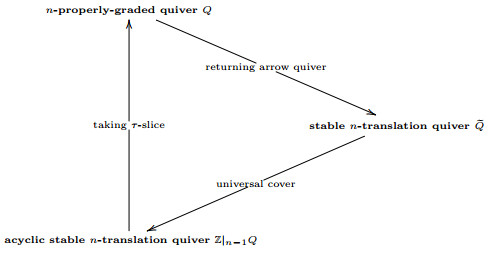
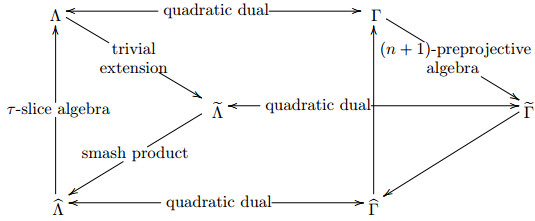

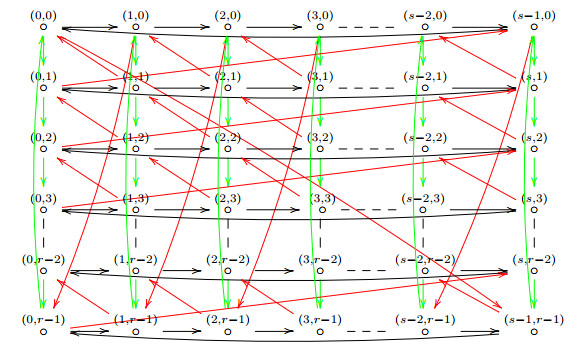
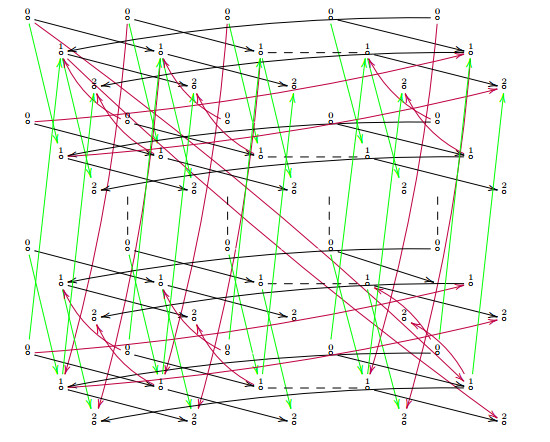
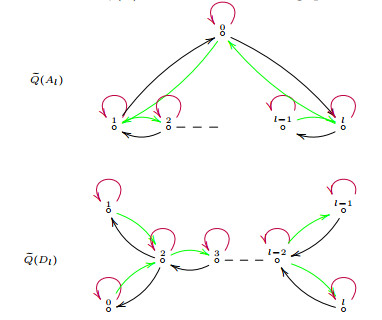
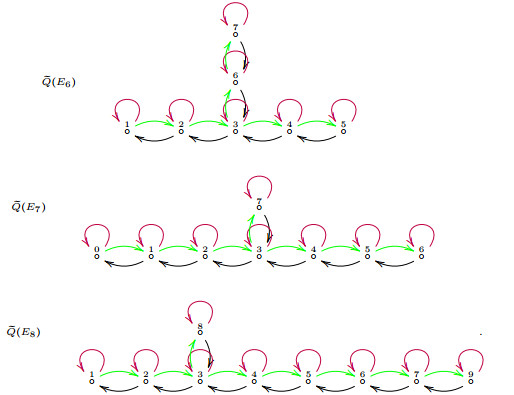
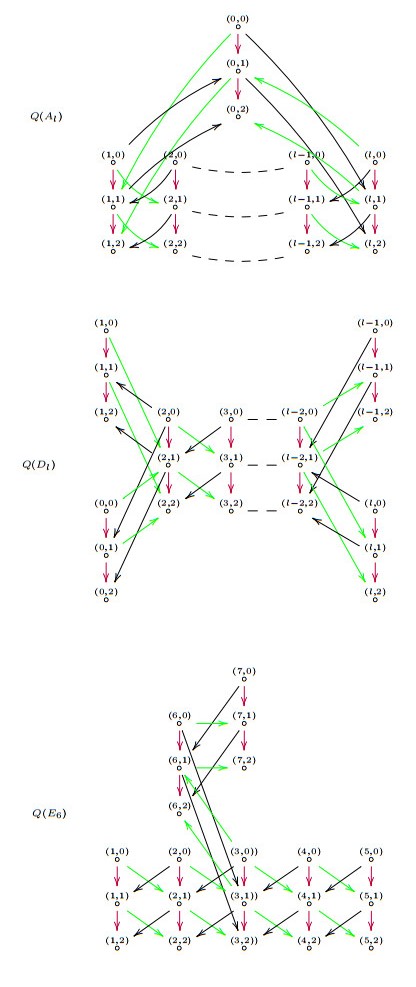
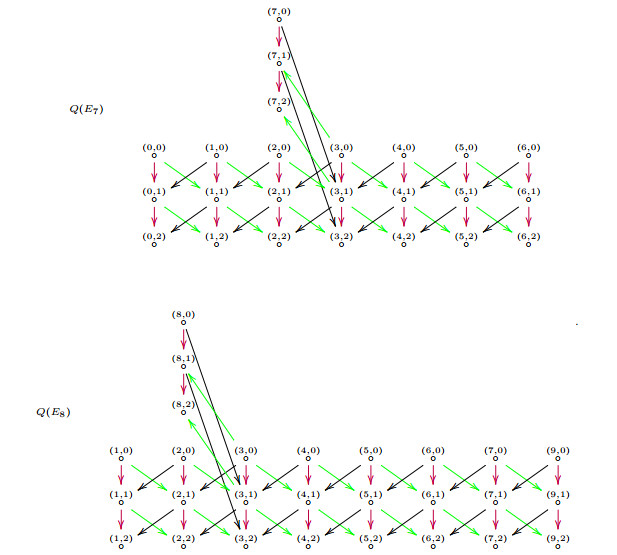


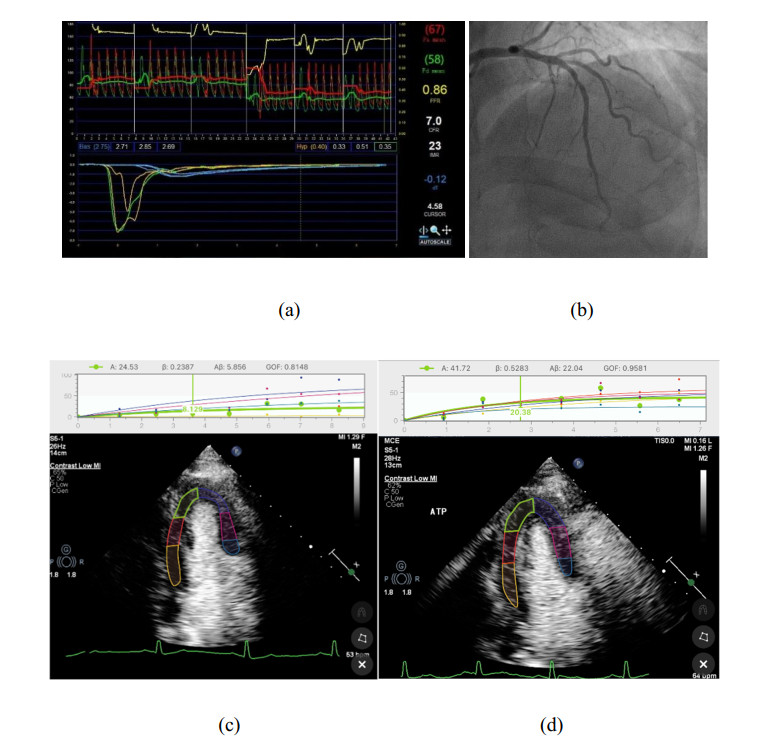
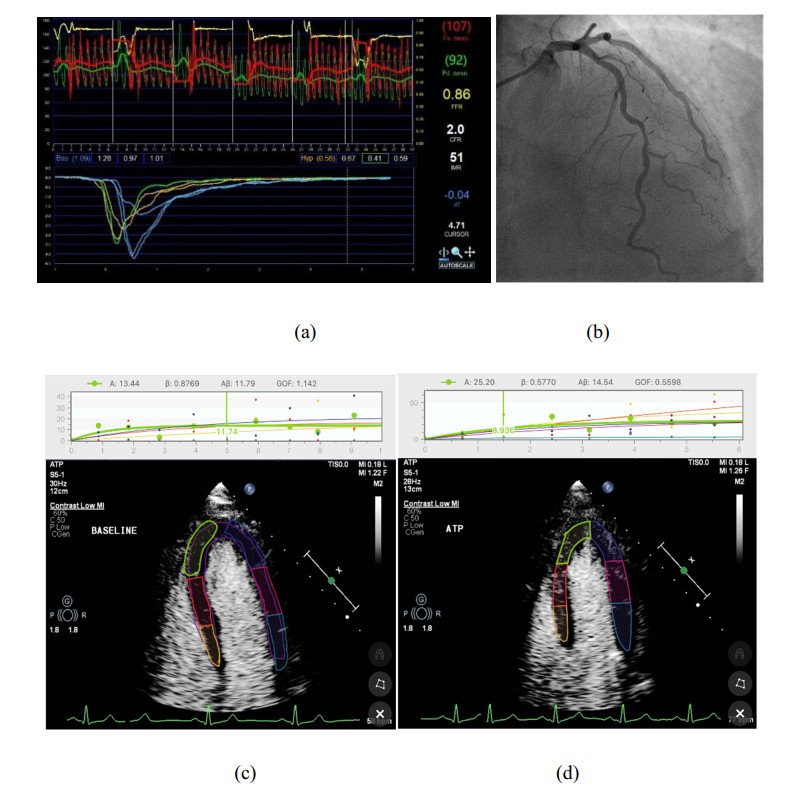
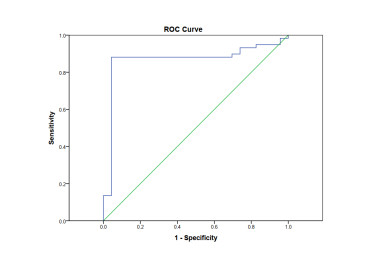
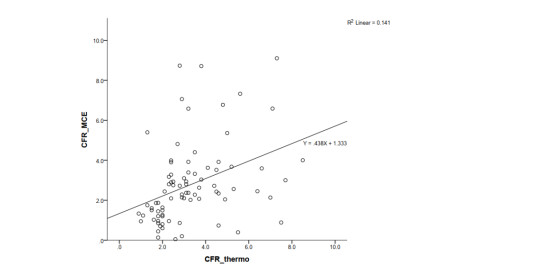


 DownLoad:
DownLoad: